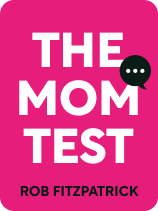

This article is an excerpt from the Shortform book guide to "The Mom Test" by Rob Fitzpatrick. Shortform has the world's best summaries and analyses of books you should be reading.
Like this article? Sign up for a free trial here.
What is the Mom Test? What do you gain out of the Mom Test?
The Mom Test by Rob Fitzpatrick is a practical guide on how to get meaningful feedback about your business or product. Fitzpatrick explains how to ask the right questions and elicit unbiased responses from customers that will move your business forward.
Read more to understand what the Mom Test is so you can master it.
The Mom Test, Explained
What is the Mom Test? Fitzpatrick’s “Mom Test” is a set of rules that ensures you receive honest feedback from customers: specifically, feedback that signals whether your idea will meet their needs and therefore be successful. The test’s name originates from the idea that mothers in particular are most likely to lie to you to spare your feelings. However, if you ask the right questions, you can get honest, valuable feedback from whomever you ask—even your mom.
(Shortform note: Is it fair for Fitzpatrick to claim that parents are dishonest—and to name a set of rules (and a book) after this claim? Arguably yes: Studies suggest that parents regularly lie to their children. They do so not just to spare their children’s feelings but also to try to prevent tantrums, maintain traditional fantasies like the existence of Santa Claus, and avoid uncomfortable topics of conversation like death and sex.)
As Fitzpatrick explains, applying the Mom Test is important because customer feedback can make or break your new business venture. Deep one-on-one conversations with potential customers can give you all the information you need to craft a successful business. However, if you fail to collect or accurately interpret honest customer feedback, you could spend months or even years pouring money into a product with irredeemable flaws—or that customers never wanted in the first place. Furthermore, failing to use the Mom Test in your discussions with customers will yield information that’s worse than useless—as we’ll see, most feedback actively pushes you toward failure by convincing you that bad ideas are good.
(Shortform note: In Principles, Ray Dalio also argues that in business, you need to actively work to get others to tell you the truth so you can avoid investing in bad ideas. Unlike Fitzpatrick, Dalio primarily applies this idea to relationships between employees rather than relationships with customers. At the hedge fund he founded, Dalio has implemented a rule of radical honesty: All employees must speak up when they disagree with anyone else, even their boss’s boss. This way, everyone at the company receives brutal but useful feedback when they propose a bad idea.)
Fitzpatrick’s Mom Test consists of three rules:
- Rule #1: Don’t pitch your idea.
- Rule #2: Ask specific questions about the past.
- Rule #3: Listen more than you talk.
(Shortform note: Although Fitzpatrick frames the Mom Test as a set of three rules, in practice, they combine to form a single mindset. In other words, following one rule at a time would be missing the point—they’re all part of a greater whole and should thus be applied concurrently.)
Let’s explore each rule of the Mom Test in detail.
Rule #1: Don’t Pitch Your Idea
Fitzpatrick’s first rule of the Mom Test is to never pitch your business idea. If you reveal what your product is, the customer will likely judge it directly—they’ll compliment the idea or give suggestions on how you can make it better. Unfortunately, such customer judgments are unreliable. People will often compliment bad ideas to spare your feelings, and they’re generally unaware of what they really want to buy. Building your business on this kind of feedback is fundamentally misguided.
Instead of pitching (or even mentioning) your business idea, ask customers about their daily lives. Fitzpatrick explains that the most valuable information you can get from a customer includes 1) their goals, 2) the problems preventing them from reaching those goals, and 3) the habitual way they currently solve their problems. Unlike customer judgments, this information is grounded in reality and is therefore objective and reliable. If you use this information to design a product or service that helps customers solve their existing problems and achieve their goals more easily and effectively than they do now, you’ll be successful.
Often, you can get information about potential customers’ lives without ever letting them know that you’re trying to get feedback from them—or that you have a business idea at all. For example, just by chatting with a stranger at the bookstore about their daily reading habits, you could gauge how viable your business idea for a new e-reader is without ever revealing that you’re an entrepreneur.
Rule #2: Ask Specific Questions About the Past
Fitzpatrick’s second rule of the Mom Test is to ask customers about the specific past, not the vague present or the hypothetical future. This rule is necessary because people are bad at accurately assessing their present habits and predicting how they would act in the future. For example, if you’re asking a stranger in a bookstore about their reading habits, don’t settle for answers like “I try to read for an hour before bed every night,” or “I would definitely read more if I had a device that made it easier.” In actuality, that stranger may currently only find the time to read once a week and is likely overestimating how much a new device would boost their motivation to read.
Instead, ask specific questions about that past that are grounded in objective fact. For example, ask questions like “Where were you the last time you sat down to read?” and “Could you walk me through what you did last night before bed?” Questions like these give you a window into the customers’ life without relying on their own distorted interpretations.
Why Customers Fail at Describing Reality
In Stumbling on Happiness, Daniel Gilbert further explains why people are so bad at assessing their present habits and predicting how they’ll feel after buying your product. In short, instead of seeing the world as it really is, our brains distort how we see the world to make us feel better about ourselves. For example, in the present, we ignore information that contradicts what we believe and compare ourselves to others who make us look better in comparison. When we predict the future, we ignore realistic yet unpleasant details to imagine a time when we’ll be much happier than we are now. We’re also totally unaware that our brains are making these subjective tweaks to reality.
In our example above, the potential customer in the bookstore fully believes that they read for an hour before bed most nights and that they would read more if they bought a new e-reader. Their brain is fabricating these realities because it helps them feel good about their self-image as a sophisticated reader.
Furthermore, according to Gilbert, our memories of the past are distorted and detached from reality, just like our assessment of the present and predictions about the future. This means that even if you specifically ask potential customers for objective facts rooted in the specific past, you may receive inaccurate responses. With this in mind, ask specific questions about the recent past, if possible, to avoid as much memory distortion as you can.
Rule #3: Listen More Than You Talk
Fitzpatrick’s third rule of the Mom Test is to listen more than you talk. Recall that you want an unfiltered view of the customer’s life. The less you talk about yourself and what you want to hear from the customer, the less biased their self-descriptions will be. If you follow Rule #1 and avoid pitching your idea, this rule should be easy to follow.
Now that we’ve explained what the Mom Test is and how to use it to get valuable feedback from discussions with customers, let’s explore how to use these conversations to support your business. Fitzpatrick advises you to approach discussions with customers in slightly different ways depending on the stage your business is in: First, before you have a product, use the Mom Test to gather information about your customers. Second, once you have a product, advance your business by getting potential customers to commit to it. Let’s inspect each of these two stages in turn.

———End of Preview———
Like what you just read? Read the rest of the world's best book summary and analysis of Rob Fitzpatrick's "The Mom Test" at Shortform.
Here's what you'll find in our full The Mom Test summary:
- How to ask the right questions to receive brutal honesty from anyone—even your mom
- How to use the “Mom Test” to gather objective feedback about your business or product
- How to extract the most important information from feedback conversations






